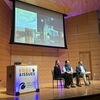Processing Your Payment
Please do not leave this page until complete. This can take a few moments.
- News
-
Editions
View Digital Editions
Biweekly Issues
- December 1, 2025
- Nov. 17, 2025
- November 03, 2025
- October 20, 2025
- October 6, 2025
- September 22, 2025
- + More
Special Editions
- Lists
- Viewpoints
-
Our Events
Event Info
Award Honorees
- Calendar
- Biz Marketplace
Speaking the same language | A Portland tech company grows along with its ability to get machinery to communicate
 Photo/Tim Greenway
Tony Paine, president of Kepware, says the technology firm is investing in sales and marketing, including reaching out to international markets
Photo/Tim Greenway
Tony Paine, president of Kepware, says the technology firm is investing in sales and marketing, including reaching out to international markets
On the fourth floor of 400 Congress St., across the street from Portland’s City Hall, is a room of software developers, each tucked into his or her gray cubicle. They work elbow to elbow, their company having outgrown its office space. Contractors have gutted the floor below and are rebuilding it to accommodate the expansion.
These developers spend the day writing software you wouldn’t install on your home or office computer, but chances are you’ve benefited from it indirectly. On New Year’s Eve, their software helps the ball in Times Square drop at the exact second that separates one year from the next; in Las Vegas, it makes sure the music, lights and water of the famed Bellagio Fountain are in sync; it was likely used in the factory that manufactured your car.
But, unless you’re in Maine’s technology sector or track the international automation industry, the chances you’ve heard of Kepware Technologies are slim.
According to its website, Kepware focuses “on the development of communication drivers to automation controllers, I/O and field devices.” In layman’s terms, Kepware creates software to allow disparate machines to communicate, similar to the software that allows your Apple MacBook Pro to communicate with your Canon MX340 printer.
Kepware is a software company with a global reputation, working with some of the world’s best-known companies, including GE, Hewlett-Packard, Siemens, Oracle and Cisco, among many others. The company posted more than $10 million in sales last year, says Tony Paine, a native of the Lewiston-Auburn area and the company’s president. But only 0.01% of those sales came from within Maine, says Corson “Corky” Ellis, the company’s founder and chairman. “We’re hard to find,” Ellis says.
For a time, being hard to find by people in Maine wasn’t a problem. As long as its customers around the country, and in Europe, China and India, were able to find Kepware and its products, local name recognition was not a priority.
But then the company began growing. Its revenue has increased between 20% and 25% year-over-year for the past eight years, Paine says. It hired eight new people last year, bringing it to just under 50 employees. It expects to hire 10 more people this year.
With growth comes the need for more employees, and Paine says finding experienced employees in Maine has always been one of Kepware’s major challenges. After so many years of toiling in obscurity, Kepware began looking to increase its visibility in Maine. While its customers may be in California, Germany or China, the talent pool the company needs to draw from is in Maine.
About three years ago, Paine and Ellis sat down to take a long-term strategic look at the company. “We sat back and said: ‘What do we want to do? Do we just want to run a business and employ people? Or do we want to do something bigger?’” Paine says. “And we recognized we both really wanted to do something much bigger.”
So the company began to develop its Maine footprint. It joined TechMaine, the industry association for Maine’s technology sector, and started networking more heavily with other local tech companies. It got involved with the University of Maine’s Electrical and Computer Engineering Department, a major source for Kepware employees, including Paine. Kepware now provides $7,500 scholarships to three UMaine engineering students each year and accepts four interns from the program every summer.
“We decided that we needed to figure out how we could make kids aware of the cool things happening in the state and hopefully keep them,” Paine says. “It’s not necessarily that the kids aren’t finding us, it’s that the industry is not doing a good job to attract the students and make them aware of our presence.”
Outsourcing: Lessons learned
Ellis founded Kepware in Portland in 1995 with little fanfare. A New Jersey transplant who wanted to live in Maine, Ellis was looking to start a company that would allow him to do so. He had been in the family hardware business — that is, building gadgets and machines for the manufacturing industry, not selling shovels and screws from a retail store — and saw an opportunity for a company that would develop HMI, or human machine interface, applications. The applications allow human users to efficiently and easily operate and manage machines. (That family business’ name was Kessler-Ellis Products, which was the inspiration for the “Kep” in Kepware.)
In those early, lean years, the company was on rocky footing. Ellis, looking to save money, had hired software developers in India to write the applications. Wrong decision, he says. “India looks cheap, but it isn’t,” Ellis says. “For every toe we got in the market, we were quickly pushed out because our quality wasn’t good enough.”
After a few years of very little growth, Ellis was faced with a tough decision. He knew he needed to stop outsourcing, but hiring local software developers would be a large financial investment. For a short time he contemplated shuttering the business.
Ellis decided to double down and hire all the developers in house. Ellis hired Paine in 1996 as a software engineer. Paine, the first member of his family to graduate from college, had left Maine after graduation looking for opportunities he thought absent in his home state and decided to try his hand in Boston, but he didn’t enjoy the city and began looking for opportunities to move back to Maine. “Kepware was a company struggling to keep the lights on, but it seemed exciting. My wife and I wanted to get back,” Paine says. “We rolled the dice and it turned out well. A lot of us were very dedicated and put a lot of effort in it.”
Around 1998, realizing the company didn’t have the resources to compete against some much larger businesses already entrenched in the HMI space, Kepware shifted its focus. Instead of providing the actual interface applications, it would produce the applications and drivers that would allow disparate systems and machinery to communicate. “We found a pretty good niche,” Paine says.
Paine explains the need for this type of software like this: “Hardware manufacturers don’t build the best software applications. They really don’t. There was a time years and years ago where a plant may standardize one vendor’s equipment from top to bottom. That doesn’t happen anymore. People want to go and buy the best parts from the right vendors and get them to work together … Kepware brings a unique, consistent interface to a wide variety of equipment.”
Paine took over as president in 2009. At the time Ellis gave up day-to-day operations of the business and now focuses on the company’s long-term direction and strategic decisions. He also has become the public face of the company, serving on boards of TechMaine, the Gulf of Maine Research Institute and the Maine Center for Enterprise Development.
Scouting new markets
For a decade, whenever Kepware made money it was reinvested into the engineering side of the business to hire more software engineers and quality assurance staff, Paine says. “We’ve been able to build the business and continue to add and grow because we have a quality product, and through word of mouth more and more people are buying and looking at our stuff,” he says.
Recently, however, Kepware has invested more in its sales and marketing in order to be “more proactive than reactive,” Paine says. Word of mouth is all well and good, but Paine hopes the new initiative will help potential clients find his company sooner.
Part of that sales and marketing initiative is evaluating the international markets it wants to penetrate more deeply. Currently, Kepware’s products and website are only in English. So far, that has worked in Europe and India, and to an extent in China, but Paine believes it alienates a large segment of potential customers who want products and marketing material in their own language. While the company sells 40% of its products outside North America, Paine would like to see that rise to 60%. “We’re missing out on a very large market and we feel that market is much larger than the market that is willing to accept an English product,” he says.
The company is deciding where to allocate its resources — China, Germany, India — because “depending on where we want to go, the challenges are different,” Paine says. “We‘re working through where do we want to make that investment. And at the same time, how do we do that with the resources we have today without spreading ourselves too thin?”
The company is also focusing on other markets besides manufacturing, the main targets being power generation and smart grid technology, oil and gas, and building automation. Some of these efforts to break into new markets will be funded by a $500,000 development grant the company received last year from the Maine Technology Institute.
To facilitate the expected growth, Paine expects to continue hiring employees, mostly in Maine. Depending on where the business chooses to focus its international efforts, there may also be the need for some overseas customer service, sales and marketing employees.
Like many Maine businesses in the technology sector, Kepware’s biggest challenge is finding experienced employees, forcing it to rely on in-house training. “That can be a six-month process to get them up to speed,” Paine says. “It’s a big investment and the whole time you’re making that investment you’re hoping it’s a win-win situation and that the employee really buys into what Kepware is all about and enjoys what we’re doing and is going to stay on long term. Because if you spend six months training them and they leave, you start all over again.”
Which brings us back to Kepware’s commitment to supporting the engineering department at UMaine. For businesses like Kepware, Ellis says “education is much more important than taxes for the economic development of the state.”
Kepware Technologies
400 Congress St., Portland
Founded: 1995
Founder: Corson Ellis
President: Tony Paine
Employees: About 50
Services: Creates communication software for electronics; develops automation drivers
Annual revenue: Over $10 million
Contact: 775-1660
www.kepware.com
Whit Richardson, a writer based in Yarmouth, can be reached at editorial@mainebiz.biz.
Mainebiz web partners

The Giving Guide
The Giving Guide helps nonprofits have the opportunity to showcase and differentiate their organizations so that businesses better understand how they can contribute to a nonprofit’s mission and work.
Learn More
Work for ME
Work for ME is a workforce development tool to help Maine’s employers target Maine’s emerging workforce. Work for ME highlights each industry, its impact on Maine’s economy, the jobs available to entry-level workers, the training and education needed to get a career started.
Learn More
Groundbreaking Maine
Whether you’re a developer, financer, architect, or industry enthusiast, Groundbreaking Maine is crafted to be your go-to source for valuable insights in Maine’s real estate and construction community.
Learn more-
The Giving Guide
The Giving Guide helps nonprofits have the opportunity to showcase and differentiate their organizations so that businesses better understand how they can contribute to a nonprofit’s mission and work.
-
Work for ME
Work for ME is a workforce development tool to help Maine’s employers target Maine’s emerging workforce. Work for ME highlights each industry, its impact on Maine’s economy, the jobs available to entry-level workers, the training and education needed to get a career started.
-
Groundbreaking Maine
Whether you’re a developer, financer, architect, or industry enthusiast, Groundbreaking Maine is crafted to be your go-to source for valuable insights in Maine’s real estate and construction community.
ABOUT
NEW ENGLAND BUSINESS MEDIA SITES
No articles left
Get access now
In order to use this feature, we need some information from you. You can also login or register for a free account.
By clicking submit you are agreeing to our cookie usage and Privacy Policy
Already have an account? Login
Already have an account? Login
Want to create an account? Register
Get access now
In order to use this feature, we need some information from you. You can also login or register for a free account.
By clicking submit you are agreeing to our cookie usage and Privacy Policy
Already have an account? Login
Already have an account? Login
Want to create an account? Register







Comments